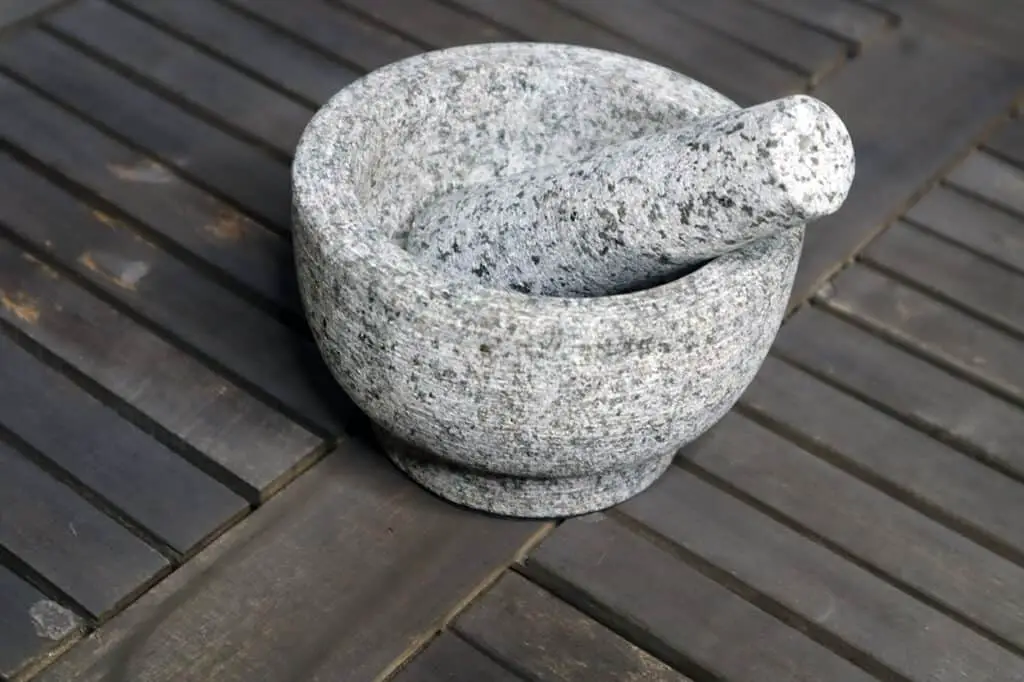You’ve likely seen this small tool used in everything from witchcraft to traditional medicine and pondered, what is a mortar and pestle? A mortar and pestle is a relatively simple and ancient tool for crushing and grinding ingredients into a powder or fine paste. Mortar and pestles will vary by material, size, and purpose, but the majority of the ones used in spell jars or other witch-related activities will fall under kitchen mortar and pestles.
If you’re planning to use a mortar and pestle for rituals and spells as well as in the kitchen, it’s recommended that you purchase one for each use. Not handling the cleaning properly of a kitchen mortar and pestle may ruin the spell or ritual you’re working on through cross-contamination.
Our team tests, researches, and carefully curates all our recommendations. This post may contain affiliate links. We may receive commission on purchases made from our links at no additional cost to you.
What Is a Mortar and Pestle?
A mortar and pestle combine two simple tools, a bowl and a small club, into a simple grinding or milling tool. It’s been used for everything from everyday kitchen use to grinding up medicine in labs or pharmacies. You’ll even find its usage in the occult when it comes to rituals and spells.
What Are a Mortar and Pestle Made of?
Traditionally, a mortar and pestle is made out of stone, ceramic, or wood. Though you’ll now find mortar and pestles made of granite, marble, or even steel. Depending on what you’re looking to use the mortar and pestle for will other determine what type of mortar and pestle you should buy.
For instance, those looking to use a mortar and pestle in their kitchen will want to stick with granite, wood, or stone. While those looking for pill crushes may want to use a steel, marble, or ceramic option. Though there are no hard guidelines when it comes to this, so use the type of mortar and pestle you connect with the best.
Are all mortar and pestles the same?
While not all mortar and pestles look the same, they can all serve the same function. Thanks to the simplicity of the mortar and pestle combination, many regions and cultures have their own version of the mortar and pestle.
For example, the Mexican molcajete has a different base, consisting of three legs rather than one large pedestal base, and has a wider mouth that’s traditionally made of basalt. While the Japanese Suribachi is often made of ceramic and looks closer to an everyday eating bowl, with a large mouth and thin walls.
When Would You Use a Mortar and Pestle?
There are multiple reasons why you’d use a mortar and pestle, ranging from grinding up herbs for a spell jar recipe to simply wanting to make your favorite guacamole dish. With that being said, this is an ancient tool, so it’s going to be simple to use but requires a great deal of effort.
When using a mortar and pestle, it’s best to make this the last step of the process, as you’re likely going to be a little tired after using it. Alternatively, you can make this the first step when prepping ingredients if the rest of the items don’t require a lot of effort.
How Do You Use a Mortar and Pestle?
To use a mortar and pestle, you’re going to place the ingredients in the mortar (which is the bowl portion), and use the pestle (the club-like tool) to mash and turn the ingredients into the desired textured.
You’ll likely have to adjust your grip on the pestle between overhand and underhand throughout the grinding process. Make sure to always hold the mortar with the other hand to prevent it from moving, even if it comes with a nonslip base.
How Is a Mortar and Pestle Used in Spells and Rituals?
In rituals and spells, a mortar and pestle may be used for grinding down herbs to place in a spell jar, potion, or medicine. Those who use animal bones in their rituals and spells will also find using a mortar and pestle is an excellent option for grinding them down into a fine powder.
FAQs
Which is the mortar and which is the pestle?
The bowl is the mortar portion and the club-like tool is the pestle.
Why is it called a mortar and pestle?
The term mortar and pestle have their roots in the Latin language and loosely translates to “using a pounder in a place for pounding”. Though it’s important to keep in mind that it’s a rough translation from Latin into English.
Other countries have more straightforward meanings though. The Japanese Suribachi has a more literal meaning, “grinding bowl”. And the Mexican Molcajete has a rough translation into “seasoning bowl”.
Is a pestle and mortar worth it?
When it comes to grinding down herbs or other ingredients for spells and rituals, a pestle and mortar are absolutely worth it. However, in the kitchen, it might be a little more worth it to simply use a blender. That is unless you’re going for a deep, seasoned taste for your food.



